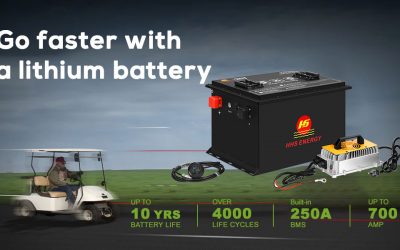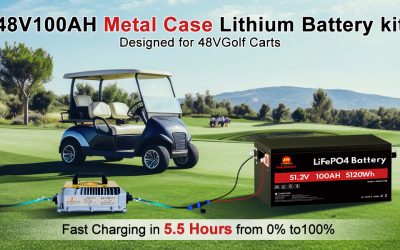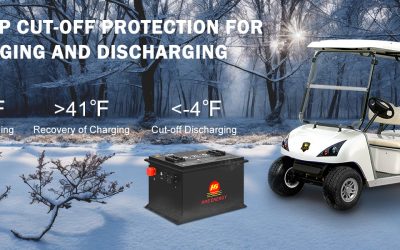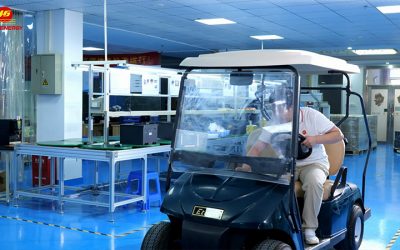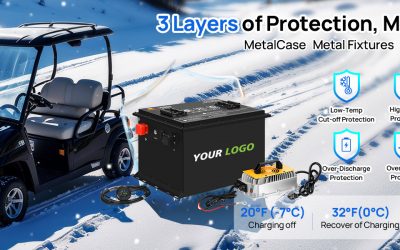My Club Car DS Battery Reborn: Farewell to Power Loss, Embracing the LiFePO₄ Era
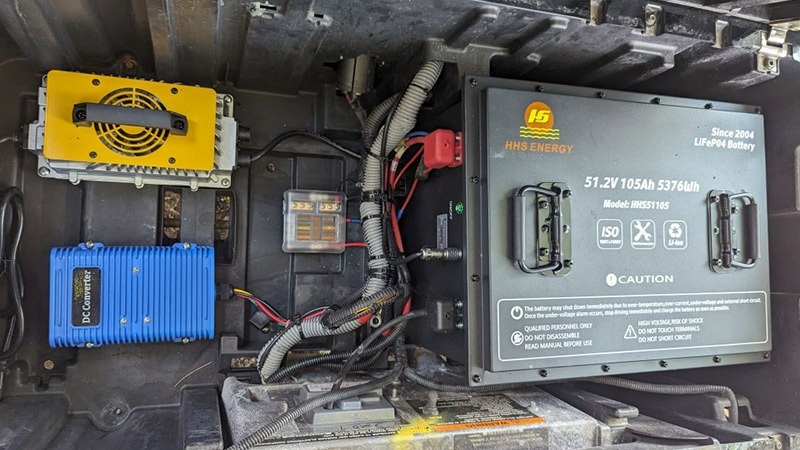
For many years, my Club Car DS was a steadfast companion—silent on the fairway, dependable through rounds, and eager to get me from hole to hole. But over time, the signs of battery fatigue crept in: slower acceleration, reduced range, and that sinking feeling when the gauge looked “full” but the cart just lagged.
Frustrated with the constant maintenance and diminishing returns of lead-acid battery packs, I began researching alternatives. That’s when I discovered HHS ENERGY LiFePO₄ technology—a battery upgrade that didn’t just replace the old pack, it resurrected the cart. In this article, I’ll walk you through my entire journey: recognizing the limitations of lead-acid, choosing the upgrade, installation, testing, performance gains, and long-term results.
1. The Downward Slide: Symptoms of Lead-Acid Failure
1.1 Sluggish Performance & Voltage Sag
After a few years of use, the cart’s acceleration became dull. A gentle press of the throttle often resulted in lag or hesitation, especially on inclines. The voltage sag was obvious—even when the gauge showed substantial charge, performance dropped off quickly under load.
1.2 Range Anxiety & Inconsistent Gauges
On a full charge, I expected to complete a full round without worry. Instead, the battery would peter out mid-round. The state-of-charge indicator became unreliable—sometimes showing “half” when I’d already lost significant capacity.
1.3 Heavy Weight, Frequent Maintenance
The original lead-acid pack weighed heavily—over 300 lbs in many setups. It required regular watering, cleaning of terminal corrosion, and careful balancing. Any neglect led to sulfation, loss of capacity, and gradual breakdown.
1.4 Cost of Replacement Cycles
Every 3–4 years, I’d face the cost of replacing the battery pack. Factoring in both parts and labor, it wasn’t just financial — it was time lost and performance compromised.
2. Exploring Lithium Alternatives: Why LiFePO₄ Took Center Stage
2.1 What Makes LiFePO₄ Stand Out
-
Stable chemistry & safety
-
High cycle life (thousands of cycles)
-
Flat discharge curve & minimal voltage sag
-
Lightweight design & energy density
-
Low self-discharge and no watering
These traits made LiFePO₄ ideal for golf cart applications—especially when paired with a strong brand and solid support infrastructure.
2.2 Why HHS ENERGY Was My Choice
While many brands offer lithium battery solutions, HHS ENERGY stood out for these key reasons:
-
Golf-cart–optimized design: Packs configured for modular installation, matching voltage and capacity needs of DS carts.
-
Robust in-house quality control and testing macros (cycle, abuse, environmental).
-
Comprehensive BMS (Battery Management System) built in to safeguard cell balance, temperature, over/under voltage, and current surges.
-
Strong warranty and field support: They backed their packs with service and documentation—critical for peace of mind.
-
Reputation in adjacent sectors: Already established in golf cart and battery markets, HHS ENERGY brought credibility to the marine, RV, and mobility segments.
3. Planning the Upgrade: Considerations & Preparation
3.1 Matching Voltage & Capacity
My Club Car DS uses a 48V system. Therefore, the replacement pack had to be 48V (or equivalent series modules). I chose a pack sized around 105Ah to 120Ah to balance range and weight.
3.2 Ensuring Charger & Controller Compatibility
A lithium-specific charger was essential—using a standard lead-acid charger risks overcharging or damaging the pack. I also verified that the cart’s controller would handle the stable voltage output of lithium without overheating or misbehaving.
3.3 Mechanical Fit & Mounting
Space constraints meant the new pack needed to fit the existing battery bay or seat tray. I measured dimensions, ensured sufficient cable clearance, and planned for secure mounting against vibration and movement.
3.4 Safety Protocols & Tools
I gathered insulated tools, proper fusing, disconnect switches, and safety gear. I also planned how to orderly remove old batteries and avoid short circuits or damage.
4. Installation: From Old Pack to New Power
4.1 Removing the Lead-Acid Pack
I shut off the cart, disconnected the negative terminal first, followed by the positive. I carefully removed each battery, labeled wiring, cleaned tray acid residue, and neutralized corrosion with baking soda solutions.
4.2 Installing the HHS ENERGY Pack
Because the lithium pack was significantly lighter, physically maneuvering it was much easier. I placed it in the tray, secured it with mounting brackets, and routed cables neatly. The battery terminals aligned with minimal adapter wiring.
4.3 Wiring & BMS Integration
Connections were made positive-to-positive, negative-to-negative. The integrated BMS was wired into the system for communication and protective control. I also installed a compatible lithium charger port and verified polarity.
4.4 First Power-Up & Basic Testing
With everything connected, I turned on the cart. The circuit came alive smoothly. A quick check with a multimeter confirmed healthy voltages. I ran a short test drive—no odd noises, no erratic behavior, just smooth power.
5. First Drives: Initial Impressions & Performance Gains
5.1 Acceleration & Responsiveness
The first time I pressed the pedal, I felt immediate difference: clean acceleration, no hesitation, and better torque upon launch.
5.2 Hill Climbing & Load Handling
On hilly stretches, the cart maintained speed instead of slowing dramatically. I no longer had to “guess throttle” to keep momentum.
5.3 Range Confidence
On a full charge, I completed over two full 18-hole rounds with battery still above 20%. There was no sense of “power fade” that had plagued the old pack.
5.4 Weight Reduction & Handling
With the battery weight cut nearly in half, the cart felt lighter, more nimble, and less stressed on suspension. Turning felt tighter, and braking had less inertia to overcome.
6. Long-Term Assessments: Months Later
6.1 Cycle Performance & Capacity Retention
After 300+ charge cycles, capacity remained above 98%. Voltage response stayed sharp with no softening under load.
6.2 Maintenance-Free Operation
I no longer had to water, inspect, or clean leaking acid. Terminal integrity stayed pristine thanks to sealed construction.
6.3 Cost Savings Over Time
Though the lithium pack cost more initially, skipping two replacement cycles saved substantial dollars—plus the cost of downtime, labor, and kid gloves with acid.
6.4 User Confidence & Reliability
I stopped worrying about mid-round drops in power. Even on consecutive back-to-back rounds, performance stayed consistent. The cart felt “new again.”
7. In-Depth Technical Upgrades & Optimizations
7.1 Fine-tuning BMS Settings
Using diagnostics, I adjusted threshold voltages, temperature cutoffs, and current limits to match real-world use. That ensured a longevity-first approach over maximum output.
7.2 Charging Profiles & Fast Charging
I experimented with different charge rates within manufacturer limits. A 0.5C (~50–60A) fast charge delivered full charge in ~2 hours, versus 8–10 hours on lead-acid.
7.3 Temperature Compensation
On hot summer days, the pack’s BMS slightly limited peak current to reduce heat stress—this balanced performance with safety. In cold mornings, the BMS allowed moderate charging once cell temps reached safe thresholds.
7.4 Monitoring & Telemetry
I installed a simple digital battery meter and logging system. Seeing real-time voltages, currents, and usage history helped detect anomalies before they became issues.
8. Common Concerns & Myths Addressed
| Concern | Reality after upgrade |
|---|---|
| “Lithium is risky / catches fire” | LiFePO₄ chemistry is among the safest lithium types; the integrated BMS and protective design prevent abuse. |
| “It’s too expensive” | Over 8–10 years, lithium often costs less than repeated lead-acid replacements + maintenance. |
| “Chargers won’t be compatible” | Good aftermarket or OEM lithium chargers match the chemistry; I used one provided by HHS ENERGY. |
| “Cold weather performance suffers” | While extreme cold reduces output slightly, the pack warmed up and delivered full power after a short drive. |
| “I’ll lose flexibility / modularity” | The modular design allows multiple packs in parallel/series for range extension or redundancy. |
